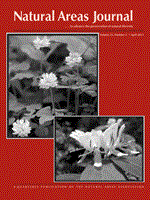Maritime forest communities on barrier islands along the Atlantic and Gulf coasts have been severely fragmented by a continuous history of human land use and natural disturbance. Isolated populations of certain tree species in maritime forest fragments may now be too small to be viable and their inability to regenerate may result in their eventual elimination from barrier islands. Using an 11-year study of a population of pignut hickory (Carya glabra), a common species of remnant maritime forest stands on St. Catherine's Island, Georgia, we present a case study of tree regeneration failure on a barrier island. We found that there has been no recruitment of new hickory individuals into the canopy of this population over the last 65 years. Field evidence of browse and a strong correlation between seedling density distributions and microsite protection from herbivory suggest that this trend in recruitment failure is related to an increased abundance of deer (Odocoileus) and pigs (Sus) on the island. Using a size class population projection model, we estimated that, if such recruitment failure and mortality rates continue, the hickory population will be extirpated from the maritime forest within 200 years. Tree species that are failing to regenerate within maritime forests represent a special challenge that is not currently being addressed in the long-term management of barrier island biodiversity.
How to translate text using browser tools
1 April 2013
Regeneration Failure in a Remnant Stand of Pignut Hickory (Carya glabra) on a Protected Barrier Island in Georgia, USA
Jonathan P. Evans,
Eric M. Keen
ACCESS THE FULL ARTICLE

Natural Areas Journal
Vol. 33 • No. 2
April 2013
Vol. 33 • No. 2
April 2013
barrier island
Maritime forest
pignut hickory
remnant stand




